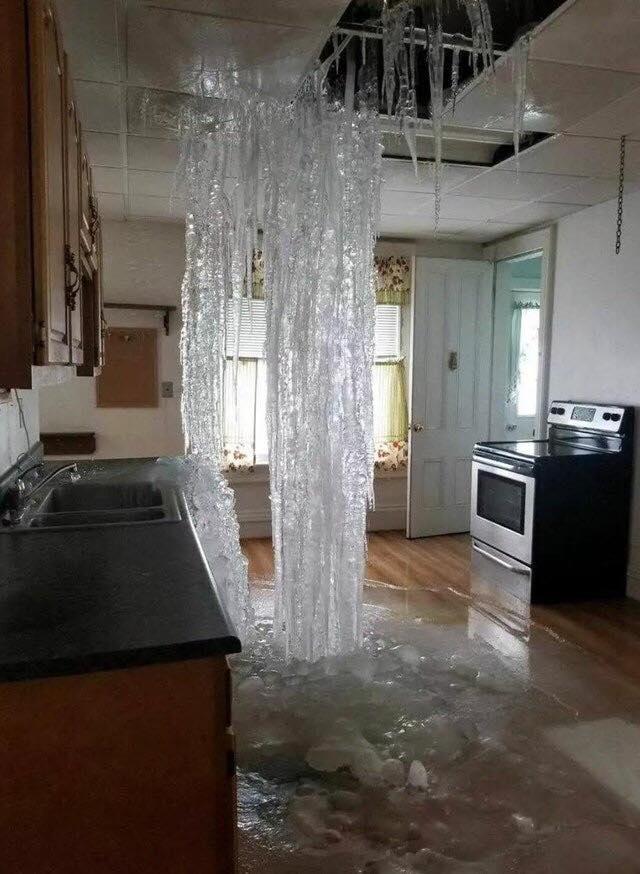You still have time to prevent broken water pipes before Old Man Winter officially arrives. Cold temperatures can cause water pipes to freeze. Freezing in a pipe creates pressure inside of the pipe, and can cause the pipe to burst and likely lead to flooding.
If no one will be using the water for some time, it is always smart to turn your water off. The best prevention against frozen pipes is to keep them warm enough to stay above the freezing point. You can do this with any one of six simple steps or, better still, a combination of measures.
Not Just for Cold Climates
It is a common misconception that frozen pipes are an issue only for homes in typically cold climates. However, homes in warmer climates are often more vulnerable to frozen pipes. These pipes may not be adequately insulated against frigid temperatures, or they may be located in unprotected areas. Wherever you live, you only need to be concerned with the water supply lines, not the drain lines. Water lines are small, only about 1 inch in diameter or smaller. Drain lines are 1 1/2 inches and larger and are usually made of plastic. Drain lines carry wastewater, but they do not hold water and are not pressurized like water pipes. Therefore, freezing inside drains is not a concern.
Tip #1: Keep the Heat On
If you are leaving for an extended period, make sure that the heat is kept on in your property. Heat can help prevent pipes from freezing, and if pipes freeze and burst, it can cause a lot of water damage to the property and personal possessions. The heat does not have to be kept as high as you regularly would keep it if you were actually in the property, but keeping it set above 50 F is a good idea. This should provide enough heat to keep the pipes warm and to prevent any water inside from freezing.
Tip #2: Allow the Faucet to Drip
If you are afraid a pipe will freeze, you can open the faucet fed by that pipe just a bit, so the faucet drips slightly. Allowing the tap to be open like this relieves pressure in the system. When a pipe freezes, it is the pressure that is created between the blockage and the faucet that will cause the pipe to burst. Allowing the valve to be open will prevent this pressure from building up and thus keep the pipe from breaking. If the faucet is served by both hot and cold water lines, open both faucet taps slightly, or set a single-handle valve (such as a kitchen faucet) to warm.
Tip #3: Keep Interior Doors Open
Pipes are often located in cabinets. When the temperature drops, it is a good idea to keep these cabinet doors open so that the heat from the rest of the house can keep the pipes warm as well. It would be best if you also kept all interior doors open so that the warm air can flow throughout the home.
Tip #4: Seal Up Cracks and Holes
Seal gaps around holes where pipes run through walls or floors, especially where the hole is letting in cold air. Use caulk or spray foam insulation to fill the gaps. If possible, seal holes on both the interior and exterior sides of the wall or floor. Cold outdoor air penetrates through holes and gaps. This can make a cabinet compartment, which is usually typically cold, even more frigid.
Tip #5: Apply Heating Tape
Heat tape works like an electric blanket for pipes, supplying heat directly to the pipe to keep it warm during cold spells. Heat tape works best for short sections of pipe that are at high risk for freezing and are easily accessible, so you can install the tape and can monitor it for problems. There are two types of heat tape. One type turns on and off by itself when it senses heat is needed. The other type must be plugged in when the heat is required and then unplugged when not in use; it does not have an automatic or manual on/off switch. Much like a space heater, these products can be dangerous, so you must follow the product’s direction and safety procedures exactly.
Tip #6: Add Extra Insulation
Pipes that are located in areas that do not have proper insulation, such as basements or attics, may need extra insulation to keep from freezing. Pipes in basements or attics are not the only ones that may not be adequately insulated from the cold. If you have had a problem with pipes freezing anywhere in your home, extra insulation could be the cure. Pipes can be fitted with foam rubber or fiberglass sleeves to help decrease the chances of freezing. This can be an easy solution for pipes that are exposed but can get expensive if walls, floors, or ceilings have to be opened to insulate the pipe properly. Additional insulation can also be added to walls and ceilings to keep the pipes warm. Insulation can help keep a pipe closer to the temperature of the water inside the pipe. Still, it does not add heat to the pipe and will not prevent freezing if the pipe is exposed to prolonged freezing temperatures. What Happens if Your Pipes do Freeze? Read more about frozen pipes at Consumer Reports

